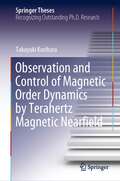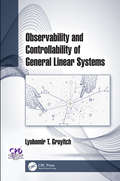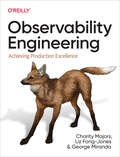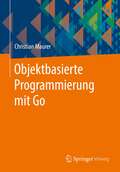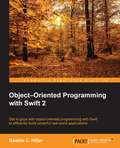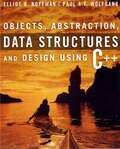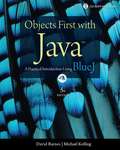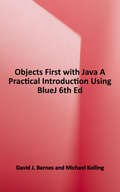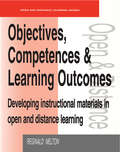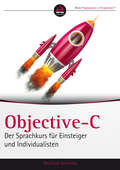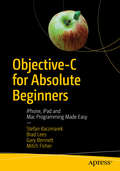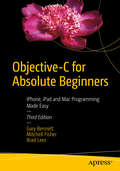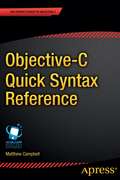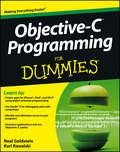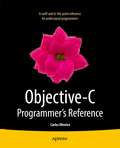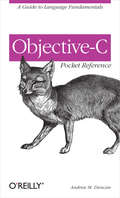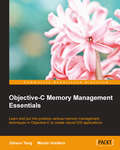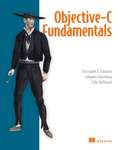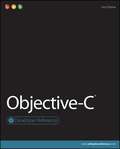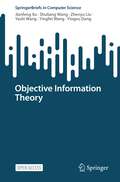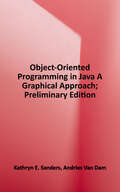- Table View
- List View
Observational Filmmaking for Education: Digital Video Practices for Researchers, Teachers and Children (Creativity, Education and the Arts)
by Nigel MeagerThis book places observational filmmaking in the context of the rapidly developing landscape of creativity and arts based research in education. The author uses observational filmmaking as a lens to address debates surrounding video based and arts based research. Utilising the work of Dewey and Deleuze as the theoretical underpinnings of the volume, this is combined with numerous practical examples of observational filmmaking in schools. The author argues that observational video camera and editing techniques combine careful observation with rigorous visual analysis: they place sensory, affectual and aesthetic qualities in experience centre stage. While observational filmmaking in itself has enormous potential as a methodology for education research, it may also become a fulcrum for children’s learning. Children record their experiences in the world around them as they look carefully with a video camera. This pioneering yet practical book will be of interest and value to students and scholars of creativity, learning, and education research methods, as well as constituting a useful guide for teachers, arts practitioners and education policy makers.
Observation and Control of Magnetic Order Dynamics by Terahertz Magnetic Nearfield (Springer Theses)
by Takayuki KuriharaThis book explicates the optical controls of antiferromagnetic spins by intense terahertz (THz) electromagnetic waves. The book comprises two key components: (1) the experimental demonstration of the enhancement of a THz magnetic field using a split-ring resonator (SRR) and (2) the control of the direction of magnetization by using the enhanced THz magnetic field to break the symmetry of optically-induced phase transition. These make up the first step leading to future spintronics devices.In the beginning of the book, the author reviews the basics of the ultrafast laser and nonlinear optical techniques as well as the previously achieved experiments to control spin dynamics by THz magnetic fields. In this context, a new experimental protocol is described, in which electron spins in a ferromagnetic material are redirected at the unprecedented level in cooperation with the enhanced THz magnetic field. Subsequently, the author demonstrates that the THz magnetic field is significantly amplified as a nearfield around the SRR structured metamaterial, which is implemented by measuring spin precession in a solid. At the end, the author presents the key experiment in which the amplified THz magnetic nearfield is applied to the weak ferromagnet ErFeO3 along with the femtosecond near-infrared pulse, demonstrating the successful control of symmetry breaking of the spin system due to coherent control of the optically-induced spin reorientation phase transition pathways. The comprehensive introductory review in this book allows readers to overview state-of-the-art terahertz spectroscopic techniques. In addition, the skillful description of the experiments is highly informative for readers in ultrafast magnonics, ultrafast optics, terahertz technology and plasmonic science.
Observability and Controllability of General Linear Systems
by Lyubomir GruyitchObservability and Controllability of General Linear Systems treats five different families of the linear systems, three of which are new. The book begins with the definition of time together with a brief description of its crucial properties. It presents further new results on matrices, on polynomial matrices, on matrix polynomials, on rational matrices, and on the new compact, simple and elegant calculus that enabled the generalization of the transfer function matrix concept and of the state concept, the proofs of the new necessary and sufficient observability and controllability conditions for all five classes of the studied systems. <P><P>Features <li>Generalizes the state space concept and the complex domain fundamentals of the control systems unknown in previously published books by other authors. <li>Addresses the knowledge and ability necessary to overcome the crucial lacunae of the existing control theory and drawbacks of its applications. <li>Outlines new effective mathematical means for effective complete analysis and synthesis of the control systems. <li>Upgrades, completes and broadens the control theory related to the classical self-contained control concepts: observability and controllability. <li>Provides information necessary to create and teach advanced inherently upgraded control courses.
Observability Engineering: Achieving Production Excellence
by Charity Majors Liz Fong-Jones George MirandaObservability is critical for building, changing, and understanding the software that powers complex modern systems. Teams that adopt observability are much better equipped to ship code swiftly and confidently, identify outliers and aberrant behaviors, and understand the experience of each and every user. This practical book explains the value of observable systems and shows you how to practice observability-driven development.Authors Charity Majors, Liz Fong-Jones, and George Miranda from Honeycomb explain what constitutes good observability, show you how to improve upon what youâ??re doing today, and provide practical dos and don'ts for migrating from legacy tooling, such as metrics monitoring and log management. Youâ??ll also learn the impact observability has on organizational culture (and vice versa).You'll explore:How the concept of observability applies to managing software systemsThe value of practicing observability when delivering and managing complex cloud native applications and systemsThe impact observability has across the entire software development lifecycleHow and why different functional teams use observability with service-level objectives (SLOs)How to instrument your code to help future engineers understand the code you wrote todayHow to produce quality code for context-aware system debugging and maintenanceHow data-rich analytics can help you debug elusive issues quickly
Objetivo: confianza
by Edurne Pasabán Angélica Del Carpio«Edurne y Angélica reflexionan en este libro sobre algo que es de gran actualidad para las empresas: la aceptación de la inseguridad y del cambio permanentes. Y cómo, a través de la confianza, los valores de innovación y flexibilidad que pedimos en las empresas, nos los debemos pedir a nosotros mismos para apasionarnos con lo que hacemos.»Josep Moragas, consejero delegado, ACC1Ó«Esta experiencia de coaching singular, es una lección de cómo la confianza en lo que hacemos, nuestras competencias y la pasión nos pueden ayudar a tomar decisiones creativas e innovadoras en situaciones de crisis. ¡Gracias, Edurne y Angélica, por vuestra generosidad al compartirlo!»Pilar Rojo, executive coa ch, profesora de dirección de personas y coaching del IE Business School«Una muestra real del arte del coaching, que nos aporta una nueva perspectiva de la responsabilidad y del compromiso. Este es un libro práctico, cercano y directo con el que se identificarán personas y organizaciones que quieran afrontar el futuro de manera constructiva.»Manuel Carreras Fisas, presidente de Sport Cultura Barcelona y coach por el IE Business School
Objektbasierte Programmierung mit Go
by Christian MaurerDieses Buch erklärt das Konzept „Objektbasierung“ als wesentlichen Teil der „Objektorientierung“ und erläutert, warum Go eine Programmiersprache ist, die dieses Konzept optimal unterstützt. Anhand wesentlicher Teile des Mikrouniversums, einer großen Sammlung von Softwarekomponenten (mit Quellcode im Umfang von mehr als 53000 Programmzeilen), werden viele wichtige Datentypen mit ihren Algorithmen beschrieben.Im praktischen Teil werden diverse Programmpakete präsentiert, die nach diesem Konzept konstruiert sind.
Objektbasierte Programmierung mit Go
by Christian MaurerDieses Buch erklärt das Konzept „Objektbasierung“ als wesentlichen Teil der „Objektorientierung“ und erläutert, warum Go eine Programmiersprache ist, die dieses Konzept optimal unterstützt. Anhand wesentlicher Teile des Mikrouniversums, einer großen Sammlung von Softwarekomponenten (mit Quellcode im Umfang von mehr als 53000 Programmzeilen), werden viele wichtige Datentypen mit ihren Algorithmen beschrieben.Im praktischen Teil werden diverse Programmpakete präsentiert, die nach diesem Konzept konstruiert sind.
Object–Oriented Programming with Swift 2
by Gaston C. HillarGet to grips with object-oriented programming in Swift to efficiently build powerful real-world applications About This Book * Leverage the most efficient object-oriented design patterns in your Swift applications * Write robust, safer, and better code using the blueprints that generate objects * Build a platform with object-oriented code by using real-world elements and represent them in your app Who This Book Is For If you are an iOS developer who has a basic idea of object-oriented programming and want to incorporate its concepts with Swift to optimize your application's code and create reusable and easily to understand building blocks, then this book is for you. This is a very useful resource for developers who want to shift from Objective C, C#, Java, Python, JavaScript, or other object-oriented languages to Swift What You Will Learn * Build solid, stable, and reliable applications using Swift * Work with encapsulation, abstraction, and polymorphism using Swift 2.0 * Customize constructors and destructors based on your needs * Develop Swift 2.0 with classes, instances, properties, and methods * Take advantage of generic code to maximize code reuse and generalize behaviors * Use state of inheritance, specialization, and the possibility to overload members * Write high quality object-oriented code to build apps for iOS or Mac OS X In Detail Object-Oriented Programming (OOP) is a programming paradigm based on the concept of objects; these are data structures that contain data in the form of fields, often known as attributes and code. Objects are everywhere, and so it is very important to recognize elements, known as objects, from real-world situations and know how they can easily be translated into object-oriented code. Object-Oriented Programming with Swift is an easy-to-follow guide packed full of hands-on examples of solutions to common problems encountered with object-oriented code in Swift. It starts by helping you to recognize objects using real-life scenarios and demonstrates how working with them makes it simpler to write code that is easy to understand and reuse. You will learn to protect and hide data with the data encapsulation features of Swift. Then, you will explore how to maximize code reuse by writing code capable of working with objects of different types. After that, you'll discover the power of parametric polymorphism and will combine generic code with inheritance and multiple inheritance. Later, you move on to refactoring your existing code and organizing your source for easy maintenance and extensions. By the end of the book, you will be able to create better, stronger, and more reusable code, which will help you build better applications. Style and approach This simple guide is packed with practical examples of solutions to common problems. Each chapter includes exercises and the possibility for you to test your progress by answering questions.
Objects, Abstraction, Data Structures and Design: Using C++
by Elliot B. Koffman Paul WolfgangKoffman and Wolfgang introduce data structures in the context of C++ programming. They embed the design and implementation of data structures into the practice of sound software design principles that are introduced early and reinforced by 20 case studies. Data structures are introduced in the C++ STL format whenever possible. Each new data structure is introduced by describing its interface in the STL. Next, one or two simpler applications are discussed then the data structure is implemented following the interface previously introduced. Finally, additional advanced applications are covered in the case studies, and the cases use the STL. In the implementation of each data structure, the authors encourage students to perform a thorough analysis of the design approach and expected performance before actually undertaking detailed design and implementation. Students gain an understanding of why different data structures are needed, the applications they are suited for, and the advantages and disadvantages of their possible implementations. Case studies follow a five-step process (problem specification, analysis, design, implementation, and testing) that has been adapted to object-oriented programming. Students are encouraged to think critically about the five-step process and use it in their problem solutions. Several problems have extensive discussions of testing and include methods that automate the testing process. Some cases are revisited in later chapters and new solutions are provided that use different data structures. The text assumes a first course in programming and is designed for Data Structures or the second course in programming, especially those courses that include coverage of OO design and algorithms. A C++ primer is provided for students who have taken a course in another programming language or for those who need a review in C++. Finally, more advanced coverage of C++ is found in an appendix.
Objects First with Java: A Practical Introduction Using BlueJ
by David J. Barnes Michael KöllingObjects First with Java: A Practical Introduction Using BlueJ, 5e, is ideal for introductory courses in Java/Introduction to Programming and Object-Oriented Programming and for beginning programmers. This is the only introductory programming textbook that uses the BlueJ integrated development environment (IDE) to teach introductory and object-oriented programming principles using Java. Its close integration with the BlueJ development environment allows this book to focus on key aspects of object-oriented software development from day one. BlueJ's clear visualization of classes and objects means that readers can immediately appreciate the differences between them, and gain a much better understanding of the nature of an object than they would from simply reading source code. Unlike traditional textbooks, the chapters are not ordered by language features but by software development concepts. Language features are introduced as a response to the problems to be solved. A large number of different, interesting projects are used to provide variety and avoid the monotony of a running problem. This book takes an "objects first" approach to teaching the traditionally difficult concepts of objects in a manipulative visual form. Throughout, the emphasis is on developing a practical approach to programming, with students encouraged to add code to existing programs rather than working with an intimidating sheet of blank paper. This textbook is printed in four-color to aid pedagogy and reader learning.
Objects First with Java: A Practical Introduction Using BlueJ
by David J. Barnes Michael KollingA Modern Approach to Functional Programming Objects First with Java: A Practical Introduction is an introduction to object-oriented programming for beginners. The main focus of the book is general object-oriented and programming concepts from a software engineering perspective. The first chapters are written for readers with no programming experience with later chapters being more suitable for advanced or professional programmers. The Java programming language and BlueJ--the Java development environment -- are the two tools used throughout the book. BlueJ's clear visualization of classes and objects means that readers can immediately appreciate the differences between them and gain a much better understanding of the nature of an object than they would from simply reading source code. Unlike traditional textbooks, the chapters are not ordered by language features but by software development concepts. The Sixth Edition goes beyond just adding the new language constructs of Java 8. The book's exploration of this new language demonstrates a renaissance of functional ideas in modern programming. While functional programming isn't new in principle, it's seen a boost in popularity based on the current computer hardware available and the changing nature of projects programmers wish to tackle. Functional language constructs make it possible to efficiently automate currency, make use of multiple cores without much effort on the side of the programmer, are both more elegant and readable, and offer great potential in solving the issue of parallel hardware. Functional programming has become an essential part of the field, and Objects First with Java gives students a basic understanding of an area they'll need to master in order to succeed in the future.
Objectives, Competencies and Learning Outcomes: Developing Instructional Materials in Open and Distance Learning (Open and Flexible Learning Series)
by Reginald MeltonThis text offers a perspective on issues surrounding student learning by addresssing questions of quality and learning effectiveness across a broad and diverse range of courses, student populations and contexts.
Objective-C: The Ultimate Guide (The Ultimate Guide)
by Sufyan bin UzayrObjective-C is a general-purpose, object-oriented programming language that extends the C programming language with Smalltalk-style messaging. While simultaneously developing for OS X and iOS, Objective-C's capabilities have been bolstered by the inclusion of a dynamic runtime and assistance for object-oriented programming. Objective-C: The Ultimate Guide walks developers and coders through a straightforward and practical method of learning the Objective-C programming language. This book discusses the basics in brief, and then moves on to more advanced and detailed exercises to help readers quickly gain the required knowledge. The focus in this book remains on writing optimized and well-structured code in Objective-C. Key Features: Follows a hands-on approach and offers practical lessons and tutorials related to Objective-C Discusses Objective-C using real world industry concepts Includes at-length discussion of Objective-C concepts to help build robust knowledge
Objective-C: Der Sprachkurs für Einsteiger und Individualisten
by Wolfram SchroersEinfach und humorvoll Objective-C lernen: Wer Apps für iPhone und iPad oder Programme für den Mac entwickeln möchte, braucht Grundlagen in Objective-C. Dieses Buch bietet den idealen Praxiseinstieg, um Schritt für Schritt das erste Programm zu entwickeln - auch ohne Vorkenntnisse. Sie lernen in "Objective-C" von Wolfram Schroers folgendes: - Grundlagen wie die Entwicklungswerkzeuge - Apps mit Schleifen und Verzweigungen programmieren - objektorientierte Programmierung - Framework Cocoa - Benutzeroberflächen der Anwendungen gestalten - Projekte auf iPhone, iPad oder Mac portieren. Der Besondere sind die Beispiele: Statt sich mit trockenen Programmieraufgaben zu langweilen, programmieren Sie Spiele oder einen Passwortgenerator. Alle Beispiele erhalten Sie zur besseren Orientierung natürlich auch zum Download. So gerüstet steht Ihren eigenen Apps und Mac-Programmen nichts mehr im Weg!
Objective-C for Absolute Beginners: Iphone, Ipad And Mac Programming Made Easy
by Gary Bennett Stefan Kaczmarek Brad Lees Mitch FisherLearn Objective-C and its latest release, and learn how to mix Swift with it. You have a great idea for an app, but how do you bring it to fruition? With Objective-C, the universal language of iPhone, iPad, and Mac apps. Using a hands-on approach, you'll learn how to think in programming terms, how to use Objective-C to construct program logic, and how to synthesize it all into working apps. Gary Bennett, an experienced app developer and trainer, will guide you on your journey to becoming a successful app developer. Along the way you'll discover the flexibility of Apple’s developer toolsIf you're looking to take the first step towards App Store success, Objective-C for Absolute Beginners, Fourth Edition is the place to start.What You'll LearnUnderstand the fundamentals of computer programming: variables, design data structures, and working with file systemsExamine the logic of object-oriented programming: how to use classes, objects, and methodsInstall Xcode and write programs in Objective-CWho This Book Is ForAnyone who wants to learn to develop apps for the iPhone, iPad, Mac, or Watch using the Objective-C programming language. No previous programming experience is necessary.
Objective-C for Absolute Beginners
by Gary Bennett Brad Lees Mitchell FisherIt seems as if everyone is writing applications for Apple's iPhone and iPad, but how do they all do it? It's best to learn Objective-C, the native language of both the iOS and Mac OS X, but where to begin? Right here, even if you've never programmed before! Objective-C for Absolute Beginners will teach you how to write software for your Mac, iPhone, or iPad using Objective-C, an elegant and powerful language with a rich set of developer tools. Using a hands-on approach, you'll learn to think in programming terms, how to use Objective-C to build program logic, and how to write your own applications and apps. With over 50 collective years in software development and based on an approach pioneered at Carnegie Mellon University, the authors have developed a remarkably effective approach to learning Objective-C. Since the introduction of Apple's iPhone, the authors have taught hundreds of absolute beginners how to develop Mac, iPhone,and iPad apps, including many that became popular apps in the iTunes App Store. What you'll learn The fundamentals of computer programming: how to understand variables,design data structures, and work with file systems The logic of object-oriented programming: how to use Classes, Objects, and Methods The flexibility of Apple's developer tools: how to install Xcode and write programs in Objective-C The power of Cocoa and Cocoa touch: how to make Mac OS X applications or iOS apps that do cool stuff Who this book is for Everyone! This book is for anyone who wants to learn to develop applications for the Mac or apps for the iPhone and iPad using the Objective-C programming language. No previous programming experience is necessary. Table of Contents Becoming a Great iPhone/iPad or Mac Programmer Programming Basics It's All About the Data Making Decisions About. . . and Planning Program Flow Object Oriented Programming with Objective-C Introducing Objective-C and Xcode Objective-C Classes, Objects, and Methods Programming Basics in Objective-C Comparing Data Creating User Interfaces with Interface Builder Memory, Addresses, and Pointers Debugging Programs with Xcode Storing Information Protocols and Delegates
Objective-C Quick Syntax Reference
by Matthew CampbellThe Objective-C Quick Syntax Reference is a condensed code and syntax reference to the popular Objective-C programming language, which is the core language behind the APIs found in the Apple iOS and Mac OS SDKs. It presents the essential Objective-C syntax in a well-organized format that can be used as a handy reference. You won't find any technical jargon, bloated samples, drawn out history lessons, or witty stories in this book. What you will find is a language reference that is concise, to the point and highly accessible. The book is packed with useful information and is a must-have for any Objective-C programmer. In the Objective-C Quick Syntax Reference, you will find: A concise reference to the Objective-C language syntax. Short, simple, and focused code examples. A well laid out table of contents and a comprehensive index allowing easy review. What you'll learn How to create an Objective-C HelloWorld How to compile and run What are the Objective-C code class definitions How to use objects in Objective-C How to effectively use categories to extend the various classes What is key-value observation How to archive an object graph How to implement the delegation design pattern with protocols How to master code blocks and much more Who this book is for This book is a quick, handy pocket syntax reference for experienced Objective-C, Mac, and iOS programmers, and a concise, easily-digested introduction for other programmers new to Objective-C. Table of Contents 1. Hello World 2. Build and Run 3. Variables 4. Operators 5. Objects 6. Strings 7. Numbers 8. Arrays 9. Dictionaries 10. For Loops 11. While Loops 12. Do While Loops 13. For-Each Loops 14. If-Statements 15. Switch Statements 16. Defining Classes 17. Class Methods 18. Inheritance 19. Categories 20. Blocks 21. Key-Value Coding 22. Key-Value Observing 23. Protocols 24. Implementing Delegation 25. Implementing Singleton 26. Error Handling
Objective-C Programming For Dummies
by Neal Goldstein Karl G. KowalskiA step-by-step guide to understanding object-oriented programming with Objective-C As the primary programming language for iPhone, iPad, and Mac OS X applications, Objective-C is a reflective, object-oriented language that all programmers must know before creating apps. Assuming no prior programming language experience, this fun-and-friendly book provides you with a solid understanding of Objective-C. Addressing the latest version of Xcode, debugging, code completion, and more, veteran author Neal Goldstein helps you gain a solid foundation of this complex topic, and filters out any unnecessary intricate technical jargon. Assumes no prior knowledge of programming and keeps the tone clear and entertaining Explains complicated topics regarding Objective-C with clarity and in a straightforward-but-fun style that has defined the For Dummies brand for 20 years Features all material completely compliant with the latest standards for Objective-C and Apple programming Objective-C Programming For Dummies is the ideal beginner book if your objective is to venture into iPhone, iPad, and Mac OS X development for the first time!
Objective-C Programmer's Reference
by Carlos OliveiraObjective-C Programmer's Reference provides the tools necessary to write software in Objective-C--the language of choice for developing iOS and OS X applications. Author Carlos Oliveira begins from the basic building blocks of the language. He shows how to create correct and efficient applications by applying your knowledge of object-oriented and structured programming. This book: Takes you quickly through fundamental concepts such as interfaces and class implementations. Provides a concise reference to the Foundation Framework that is all-important when programming in Objective-C. Highlights key differences between Objective-C and other popular languages such as Java or Python. Provides the fundamentals of Cocoa and Cocoa Touch, which are the standard for OS X and iOS development. Objective-C Programmer's Reference makes extensive use of concepts already mastered by developers who are fluent in other languages such as C++, Java, Perl, and Python. The author's approach is logical and structured, and even novice developers will have an easy time absorbing the most important topics necessary to program in Objective-C. Objective-C Programmer's Reference is a book for professional developers in Objective-C, or those who are moving to Objective-C from other languages. The book is written for readers who lack the time to invest in more traditional books, which usually spend hundreds of pages to explain concepts that are part of the working programmer's standard vocabulary. What you'll learn Grasp the basic syntax of the Objective-C language. Create classes and methods in Objective-C. Apply Objective-C's message-passing mechanism to simplify your code and avoid deep class hierarchies. Store and access dynamic data through Objective-C's built-in, key-value system. Make effective use of container classes such as arrays and dictionaries with their immutable and mutable versions. Create simple applications for iPhones, iPads, Macbooks, and other iOS and Mac OS X devices. Who this book is for Objective-C Programmer's Reference is for programmers in Objective-C who are looking for a handy reference to keep them on top of their game. The book is also designed for programmers moving to Objective-C from some other language, especially from another C-like language such as Java or C#, providing just that additional bit that is needed to transfer their expertise into Objective-C and get a leg up on creating applications for the iOS and OS X platforms underlying Apple's hugely successful devices such as the iPhone, iPad, and Macbook. Table of Contents Part I: The Language 1. The C in Objective-C 2. Classes 3. Strings and Container Classes 4. Protocols and Categories 5. Inheritance 6. Block Syntax 7. Dynamic Binding 8. Memory Management 9. Key-Value Programming 10. The Filesystem Part II: Reference 11. The Foundation Framework Part III: The Tools 12. The Compiler 13. The Preprocessor 14. Unit Test 15. Debugging Part IV: Writing Apps for OS X and iOS 16. Cocoa Framework Example 17. Cocoa Touch Example
Objective-C Pocket Reference: A Guide to Language Fundamentals
by Andrew DuncanObjective-C is an exciting and dynamic approach to C-based object-oriented programming; it's the approach adopted by Apple as the foundation for programming under Mac OS X, a Unix-based operating system gaining wide acceptance among programmers and other technologists. Objective-C is easy to learn and has a simple elegance that is a welcome breath of fresh air after the abstruse and confusing C++. To help you master the fundamentals of this language, you'll want to keep the Objective-C Pocket Reference close at hand. This small book contains a wealth of valuable information to speed you over the learning curve.In this pocket reference, author Andrew Duncan provides a quick and concise introduction to Objective-C for the experienced programmer. In addition to covering the essentials of Objective-C syntax, Andrew also covers important faces of the language such as memory management, the Objective-C runtime, dynamic loading, distributed objects, and exception handling.O'Reilly's Pocket References have become a favorite among programmers everywhere. By providing important details in a succinct, well-organized format, these handy books deliver just what you need to complete the task at hand. When you've reached a sticking point in your work and need to get to a solution quickly, the new Objective-C Pocket Reference is the book you'll want to have.
Objective-C Memory Management Essentials
by Gibson Tang Maxim VasilkovIf you are new to Objective-C or a veteran in iOS application development, this is the book for you. This book will ensure that you can actively learn the methods and concepts in relation to memory management in a more engaging way. Basic knowledge of iOS development is required for this book.
Objective-C Fundamentals
by Christopher Fairbairn Collin Ruffenach Johannes FahrenkrugSummaryObjective-C Fundamentals is a hands-on tutorial that leads you from your first line of Objective-C code through the process of building native apps for the iPhone using the latest version of the SDK. You'll learn to avoid the most common pitfalls, while exploring the expressive Objective-C language through numerous example projects.About the TechnologyThe iPhone is a sophisticated device, and mastering the Objective C language is the key to unlocking its awesome potential as a mobile computing platform. Objective C's concise, rich syntax and feature set, when matched with the iPhone SDK and the powerful Xcode environment, offers a developers from any background a smooth transition into mobile app development for the iPhone.About the BookObjective-C Fundamentals guides you gradually from your first line of Objective-C code through the process of building native apps for the iPhone. Starting with chapter one, you'll dive into iPhone development by building a simple game that you can run immediately. You'll use tools like Xcode 4 and the debugger that will help you become a more efficient programmer. By working through numerous easy-to-follow examples, you'll learn practical techniques and patterns you can use to create solid and stable apps. And you'll find out how to avoid the most common pitfalls.No iOS or mobile experience is required to benefit from this book but familiarity with programming in general is helpful. Purchase of the print book comes with an offer of a free PDF, ePub, and Kindle eBook from Manning. Also available is all code from the book. What's InsideObjective-C from the ground upDeveloping with Xcode 4Examples that work unmodified on iPhoneTable of ContentsPART 1 GETTING STARTED WITH OBJECTIVE-CBuilding your first iOS applicationData types, variables, and constantsAn introduction to objectsStoring data in collectionsPART 2 BUILDING YOUR OWN OBJECTSCreating classesExtending classesProtocolsDynamic typing and runtime type informationMemory managementPART 3 MAKING MAXIMUM USE OF FRAMEWORK FUNCTIONALITYError and exception handlingKey-Value Coding and NSPredicateReading and writing application dataBlocks and Grand Central DispatchDebugging techniques
Objective-C
by Jiva DevoeA soup-to-nuts guide on the Objective-C programming languageObjective-C is the language behind Cocoa and Cocoa Touch, which is the Framework of applications written for the Macintosh, iPod touch, iPhone, and iPad platforms. Part of the Developer Reference series covering the hottest Apple topics, this book covers everything from the basics of the C language to advanced aspects of Apple development. You'll examine Objective-C and high-level subjects of frameworks, threading, networking, and much more.Covers the basics of the C language and then quickly moves onto Objective-C and more advanced topicsDraws from the author's first-hand experience garnered while developing applications for the Mac and iPhone OS platformsIncludes chapters on classes, memory management, threads, and the Foundation frameworkAlso covers advanced topics like protocols, categories, associated objects, and blocksFeaturing real-life examples drawn from the author's experience, Objective-C offers an insider look at this amazing programming language.
Objective Information Theory (SpringerBriefs in Computer Science)
by Shuliang Wang Zhenyu Liu Jianfeng Xu Yashi Wang Yingfei Wang Yingxu DangObjective Information Theory (OIT) is proposed to represent and compute the information in a large-scale complex information system with big data in this monograph. To formally analyze, design, develop, and evaluate the information, OIT interprets the information from essential nature, measures the information from mathematical properties, and models the information from concept, logic, and physic. As the exemplified applications, Air Traffic Control System (ATCS) and Smart Court SoSs (System of Systems) are introduced for practical OITs. This Open Access book can be used as a technical reference book in the field of information science and also a reference textbook for senior students and graduate ones in related majors.
Object-oriented Programming in Java: A Graphical Approach
by Kathryn E. Sanders Andries Van DamThis book has a strong focus on object-oriented design and gives readers a realistic experience of writing programs that are systems of cooperating objects. Programming fundamentals are learned through visually appealing graphics applications in all examples and exercises. Introduction of object-oriented concepts from the beginning including objects, classes, polymorphism, inheritance, and interfaces. It fully embraces Java 5.0 topics including the standard scanner class and makes extensive use of graphical user interfaces and real graphics applications. This book is appropriate for beginning programmers who want to learn to program with Java as well as experienced programmers who want to add Java to their skill set.

